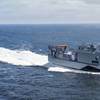Sailors man the rails of the amphibious transport dock USS San Antonio (LPD 17) as it arrives at her new homeport of Naval Station Norfolk. San Antonio is the lead ship in the Navy’s newest amphibious transport dock-class of ships. She is scheduled to stay at Naval Station Norfolk for the holidays and then sail to Ingleside, Texas for her commissioning ceremony, Jan. 14, 2006. U.S. Navy photo by Journalist Seaman Apprentice Charles A. Ordoqui
The U.S. Navy will commission the USS San Antonio, lead ship of the latest class of amphibious ships, at 11 a.m., Saturday, Jan. 14, at Naval Station Ingleside, Texas.
Former President George H. W. Bush will deliver the ceremony’s principal address. Sen. Kay Bailey Hutchison will serve as the ship’s sponsor and will give the first order to “Man our ship and bring her to life!”
Capt. Jonathan M. Padfield of Salt Lake City, Utah, is the ship’s first commanding officer and will lead a crew of 360 officers and enlisted personnel. The ship is capable of embarking a landing force of up to 800 Marines.
Built by Northrop Grumman Ship Systems, San Antonio is 684 feet in length, has an overall beam of 105 feet, a navigational draft of 23 feet and displaces about 25,000 tons. Four turbo-charged diesels power the ship to sustained speeds of 24 knots. As a member of the U.S. Atlantic Fleet, San Antonio will be homeported in Norfolk, Va.
San Antonio is the lead ship in the Navy’s new LPD 17 class that will serve as the functional replacement of four amphibious ship classes, LPD 4, LSD 36, LST 1179 and LKA 113, that have reached or are nearing the end of their service life.
The ship will provide greatly improved warfighting capabilities including: an advanced command and control suite; increased lift capacity with substantial increases in vehicle and cargo carrying capability; and advanced ship survivability features. The ship supports the Marine Corps "mobility triad," the Landing Craft Air Cushion vehicle, the Expeditionary Fighting Vehicle and the MV-22 Osprey tiltrotor aircraft, making this class a critical element of tomorrow’s amphibious ready groups and expeditionary strike groups.
The new design also features the latest in command, control, communications, computers, intelligence, surveillance and reconnaissance capabilities with dedicated intelligence, mission planning and command and control spaces. San Antonio’s shipboard wide area network is a fiber optic shipwide large area computer network, which will support numerous operations including combat systems, ship systems, command and control nodes, and an integrated training system.
This expeditionary warship class will be the most survivable amphibious vessel ever put to sea. The ship's automated combat system includes a highly capable sensor suite and weapons that provide a robust self-defense capability. San Antonio's design reduces its radar cross-section signature by streamlining topside design and incorporating other advanced technologies.
San Antonio also features the advanced enclosed mast/sensor system (AEM/S) that replaces conventional masts, protecting radar and communications antennae from weather and reducing the ship’s vulnerability to detection by hostile radar. The AEM/S, the defining feature of the ship’s distinctive profile, is the largest composite material structure ever installed on a U.S. Navy steel ship.
Furthermore, San Antonio incorporates the latest quality of life standards for the embarked Marines and sailors, including the sit-up berth, ship services mall, a fitness center and learning resource center/electronic classroom. The ship has the flexibility to accommodate a mixed-gender crew and embarked troops.
Reduced operational costs and an improved capability to periodically insert advanced technology over its planned 40-year service life were also essential design objectives for LPD 17. Accordingly, the design team incorporated hundreds of suggestions and recommendations received from sailors and Marines during formal review sessions in a "Design for Ownership" process to ensure that these ships will meet their needs throughout the first half of the 21st century.
Source: NavNews
Sponsored Content
Anschuetz USA: Supporting the U.S. Maritime Industry

Maritime leaders unite to tackle ocean plastic with launch of new alliance: the Maritime Association for Clean Seas

Subscribe for
Maritime Reporter E-News
Maritime Reporter E-News is the maritime industry's largest circulation and most authoritative ENews Service, delivered to your Email five times per week








